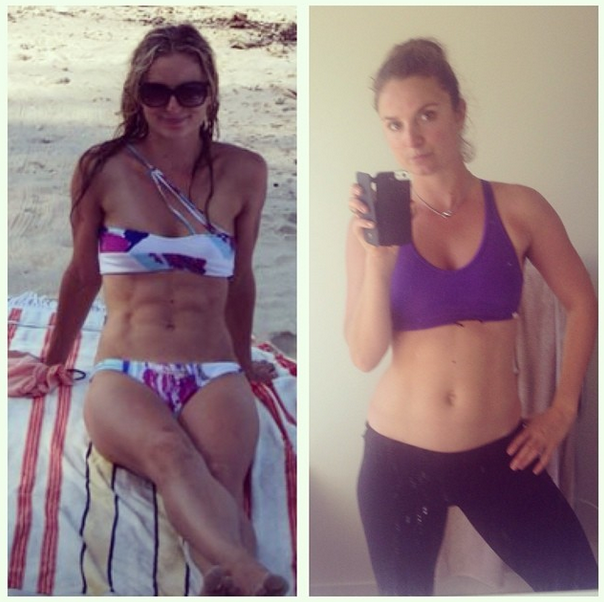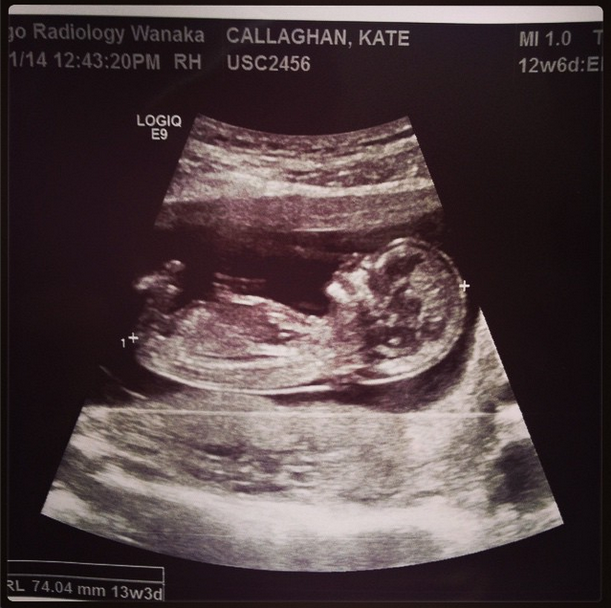I don’t normally run guest posts on this blog. But this topic is very close to my heart and my mate Kate Callaghan and I have been talking about this issue together for a while. She recently emailed to share she’d become pregnant only 15 months after being told she was infertile and kids were a pipe dream. I’ve watched her systematically shift her reproductive health one change at a time, and have implemented many myself, too. I always promised that whoever proved the doctors wrong first would have to share their tale of victory on my blog, since I know many of you here reading this are in the same “barren” boat.
Kate, bravo to you and congratulations…over to you…

A few years ago, I lost my period. I was diagnosed with a condition called hypothalamic amenorrhea, which basically meant that my brain had stopped communicating with my ovaries, thus halting my menstrual cycle and ovulation. Why? Because I was a stressed-out, over-exerciser and under-eater. You can read more about that here and here.
I was infertile, and I was told by many doctors that I would be unable to conceive naturally and should commence assisted reproductive technology.
The thing is, I’m pretty stubborn, and when someone tells me I can’t do something, I will go out of my way to prove them wrong. Plus, I intuitively knew that my body was capable of healing itself – it just needed a little time and TLC. Fifteen months after implementing some pretty significant changes, my husband and I conceived naturally. Here’s how I reversed my infertility:
1. I quit cardio
As a group fitness instructor who taught Body Attack, Body Step and Body Pump for a living, this was a tough one. I was doing at least one hour of cardio every day, sometimes up to three hours. I loved the endorphin hit these classes would give me, however the chronic cardio was destroying my health. Exercising at high intensity for this length of time was increasing my levels of cortisol (our stress hormone) and subsequently telling my brain that this was not an ideal time for reproduction. My sex hormones decreased and my menstruation ceased.
Since the beginning of this year, I have cut that down even further to just one Body Pump class per week.
Please note I didn’t just become a sloth. I started walking in nature as often as I could, which was incredibly healing for my mind and body, helping to bring my hormones back into balance. I also practiced yoga on a daily basis, which helped me to reduce my stress levels, and appreciate my body’s ability, rather than focusing on its aesthetics.
[I have done the same over a period of four years. You can read about my exercise routine, too – Sarah.]
2. I gained 5kg, mostly fat
For as long as I can remember, I have had a six-pack (abs, not beer). In a sense, my body defined me, with people often coming up and telling me that I had “the ideal body”. I was 13 per cent body fat, which is about the level of a competitive figure athlete DURING competition. I looked healthy, but was quite the opposite.
There is an important hormone called “leptin” which is produced in our fat cells. Leptin has the role of telling the brain that there is sufficient energy for reproduction, which then causes the release of a cascade of hormones responsible for a healthy menstrual cycle. No body fat = no leptin = infertility. Ergo, I needed to add some padding.

3. I increased my calorie intake by 30%
I remember tracking my calorie intake a couple of years ago, and I was sitting at about 1400kcal per day. My resting metabolic rate (the amount of energy I needed to consume for all of my organs to function, if I were to stay in bed all day) was 1340kcal. So I was doing 1-2 hours of exercise per day, working with around 60kcal. My body was in a state of starvation.
With reproduction being quite an energy intensive process, this was the last thing that was going to happen for me. So I increased my calorie intake to at least 2000kcal per day AS WELL AS cut down on exercise, to restore my body to energy sufficiency and thus restore my fertility.
4. I quit low-carb Paleo
Back in the day, I was eating about 70 per cent fat, 20 per cent protein and 10 per cent carbs. That’s how I thought one should “do Paleo”. This might be all well and good for someone who is overweight and sedentary, but for a lean, active female, it spells disaster.
My thyroid slowed down, as insulin (which is released through consumption of carbohydrate foods) is required for the production of active thyroid hormone. My adrenals were growing tired as I constantly relied on cortisol to pull glucose from my liver and muscles to fuel the exercise I was doing. My gut bacteria were being thrown out of balance, as I wasn’t providing any food for the beneficial microbes (gut bugs love whole-food sources of carbs).
So I ate more carbs (to about 30-40 per cent of my diet) – quinoa, buckwheat, sweet potato, white potato, parsnip, rice, a little fruit, full fat dairy. Still kind of Paleo, but many will argue otherwise.
[I do the same thing…which is why I’ve never described myself as “Paleo”. I simply avoid gluten and processed carbs – Sarah.]
5. I stopped wearing stress as a badge of honour
Looking back, the number one factor that affected my fertility was stress. I was one of those Type-A personalities who would walk around parading my high levels of stress, as if it were some sign of success. Again, this was driving up the levels of stress hormones in my body, creating widespread inflammation and shutting off all chances of conception.
Reproduction is not an essential bodily function. If your body is in a state of stress, all resources will be shunted towards vital functions only. In my practice, I find that stress is something not many people want to address. I strongly encourage you, if you have any health issues, to address this aspect of your life first.
6. I tracked my cervical mucus!
These days we rely so much on doctors and blood tests to tell us what we, as females, should inherently know – when we are ovulating and thus, when is the best time to try to conceive.
Natural Fertility Awareness encourages the tracking of body temperature and cervical mucus (sounds gross, but is fascinating) to show when (or even if) we are ovulating and therefore fertile. Using this method, I could pinpoint when in my cycle we should be having sex (although we tried to have sex as often as possible – it strengthens fertility in itself). Whenever I had blood tests to check my status, it always came back that I had not ovulated, when in reality I knew that I had. Why was this happening? Because my cycles were longer than “normal”, and so my hormones did not follow the “normal” trajectory.
If a doctor tells you that you aren’t ovulating, smile politely and start tracking your body’s actual signs and symptoms – it is empowering to be able to take your fertility into your own hands.

7. I used the moon to regulate my cycle
Yes, a little bit hippy, but when I first restored my menstrual cycle, it was very irregular. I didn’t want to have to wait 45 days between trying for a baby, so I learnt a technique called “Lunaception”, where you sleep with your curtains open for the 3 days surrounding the full moon. It worked! My cycles became regular and I believe I even conceived on the full moon! Freaky, right?
Final note: don’t let the naysayers get you down or tell you how it’s going to be. As Henry Ford said – “Whether you think you can, or think you can’t – you’re right”.
Kate is a holistic nutritionist specialising in hormone healing based in Wanaka, New Zealand. She works with women from all over the world, helping them to restore hormone balance and fertility. [And she’s a top chick – Sarah.]
If you have questions for Kate or I about this topic, post below.

